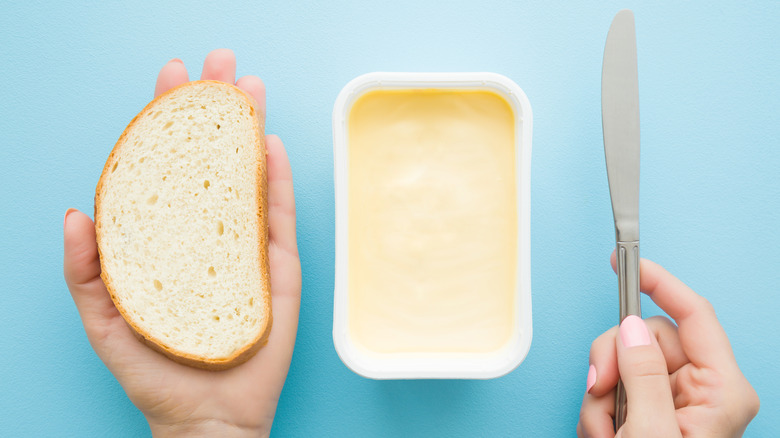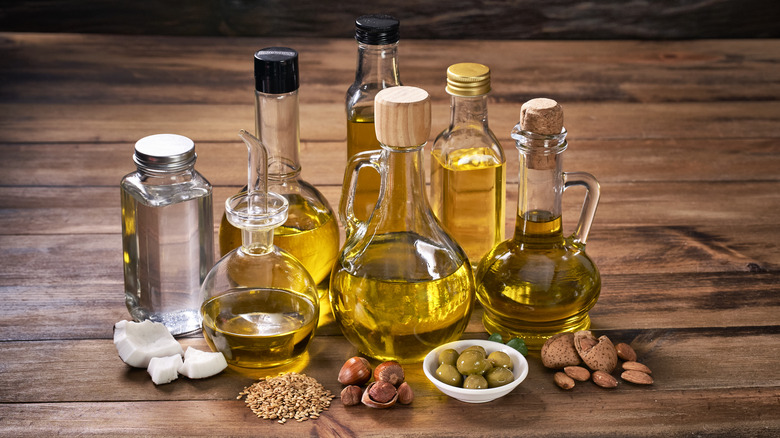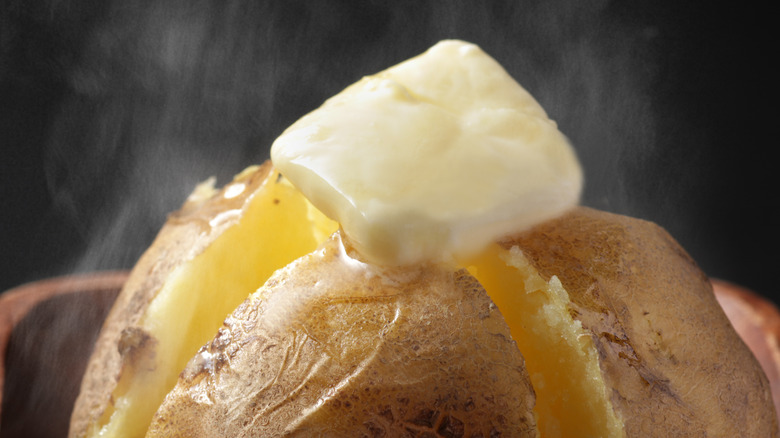What Ingredients Are Really In Dairy-Free Butter Products?
Butter alternatives are no longer trying to make you believe they are butter. What exactly, then, is in a tub of dairy-free butter? Dairy-free butter — or plant-based butter — is a type of spread made mostly from emulsified vegetable fat. "Vegetables have fat?" you ask, and the answer is yes. Avocados, olives, and corn have significant fat content, with avocados topping the charts at 15.4 grams of fat per 100-gram serving. Many other plants have oil-rich seeds and legumes that are used in similar ways for their fat, popularly soy, peanut, sunflower, and palm. Other than vegetable fats or oils, dairy-free butter also contains ingredients like coloring and flavoring, including salt, to mimic the look and flavor of its dairy counterpart.
Is dairy-free butter then just margarine with a fancier name? While both products are likely free from animal products, it is not quite the same thing. Margarine has suffered a bad rap in the last few decades, as the industrial process of making margarine (more on that later) had an undesirable by-product — trans fat — which medical research shows has potentially detrimental effects on our hearts. Thankfully, technology has come a long way since the invention of margarine. These days, there is nary a trans fat in sight on the nutrition labels of dairy-free spreads, making them a viable choice for those needing plant-based butter alternatives.
The making of dairy-free butter
Vegetable oils abound in supermarkets, and there is probably olive oil on your kitchen counter right now. But if butter is solid at room temperature, what is done to liquid vegetable oil to make it solid? The traditional answer is hydrogenation. The fats in naturally occurring vegetable oils are unsaturated. To raise the melting point of oils at room temperature, hydrogen is added, converting the aforementioned unsaturated fats into saturated fats, essentially solidifying them. This is the industrial process that gives off trans fat as a by-product, which, per FDA regulations, is required to be declared on nutrition labels.
So, how is dairy-free butter different? Well, many of them are made via emulsification, meaning the combination of two incompatible liquids — in this case, water and fat — to create a stable product. If you have ever made your own mayonnaise, you know exactly what emulsification is, as the process relies on the exact same concept. Many dairy-free butters also contain lecithins, a type of natural substance that acts to homogenize its texture.
In a nutshell, both emulsification and homogenization through natural ingredients help create the spreadability and mouthfeel of dairy-free butter. Vegetarians and vegans rejoice!
Using dairy-free butter
If you are vegan, vegetarian, or simply curious, it is not difficult to make the switch from butter to dairy-free and plant-based alternatives. However, you should pay attention to the specific ingredients of different brands of dairy-free butter to know what to use in which case.
Butter is traditionally used for many different applications, from spreading on toast to baking, and specialized instances like whipped butter and making a buttercream frosting. Due to the varying ingredients of different dairy-free butters, you may need to experiment to see which will suit your needs. Cultured (read: fermented) dairy-free butter tends to offer a tangier taste for those seeking to use butter straight up, like on sandwiches and baked potatoes. Additionally, those with added nuts have a creamier mouthfeel. For use in baking and high heat, look for ingredients that will incorporate and melt well, like palm oil and sunflower oil.


